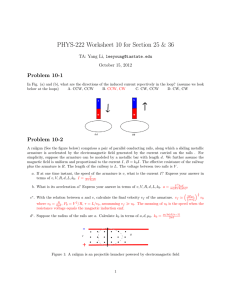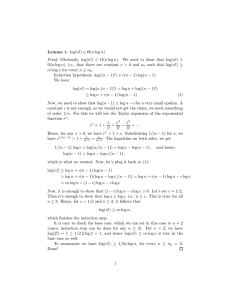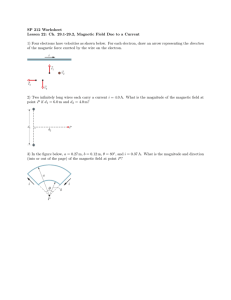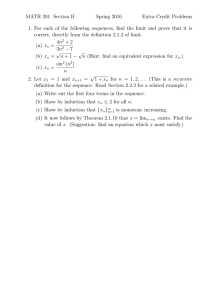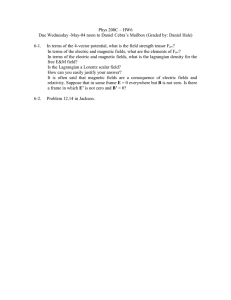An Ignored Mechanism for the Longitudinal Recoil Force in Railguns
advertisement
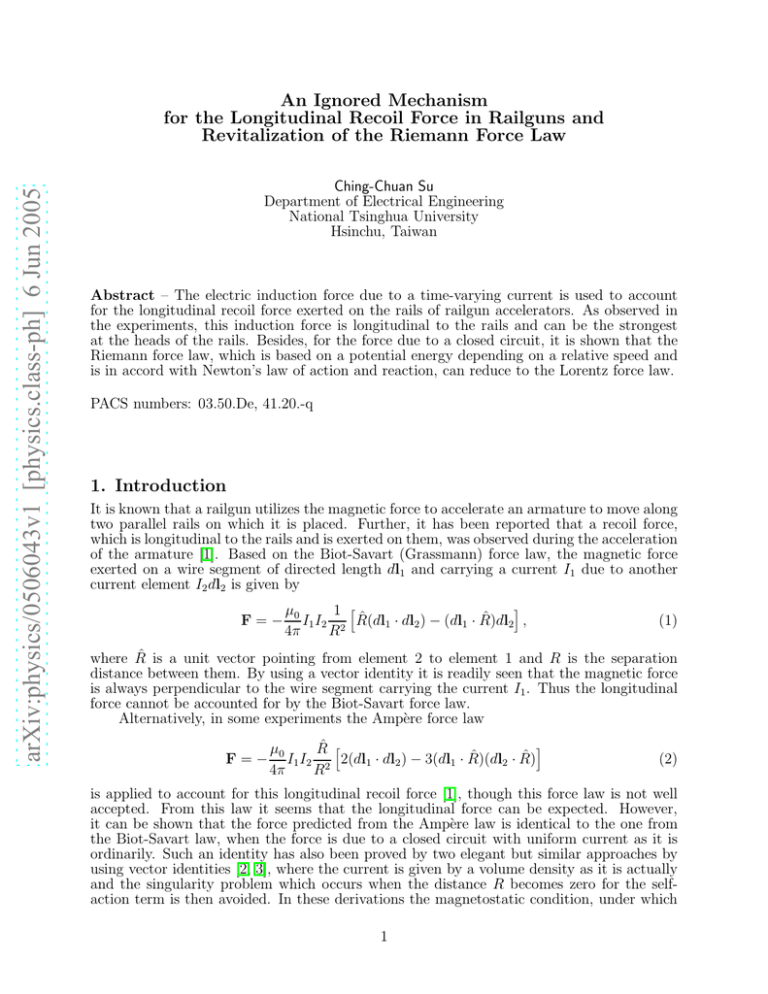
arXiv:physics/0506043v1 [physics.class-ph] 6 Jun 2005 An Ignored Mechanism for the Longitudinal Recoil Force in Railguns and Revitalization of the Riemann Force Law Ching-Chuan Su Department of Electrical Engineering National Tsinghua University Hsinchu, Taiwan Abstract – The electric induction force due to a time-varying current is used to account for the longitudinal recoil force exerted on the rails of railgun accelerators. As observed in the experiments, this induction force is longitudinal to the rails and can be the strongest at the heads of the rails. Besides, for the force due to a closed circuit, it is shown that the Riemann force law, which is based on a potential energy depending on a relative speed and is in accord with Newton’s law of action and reaction, can reduce to the Lorentz force law. PACS numbers: 03.50.De, 41.20.-q 1. Introduction It is known that a railgun utilizes the magnetic force to accelerate an armature to move along two parallel rails on which it is placed. Further, it has been reported that a recoil force, which is longitudinal to the rails and is exerted on them, was observed during the acceleration of the armature [1]. Based on the Biot-Savart (Grassmann) force law, the magnetic force exerted on a wire segment of directed length dl1 and carrying a current I1 due to another current element I2 dl2 is given by F=− i µ0 1 h I1 I2 2 R̂(dl1 · dl2 ) − (dl1 · R̂)dl2 , 4π R (1) where R̂ is a unit vector pointing from element 2 to element 1 and R is the separation distance between them. By using a vector identity it is readily seen that the magnetic force is always perpendicular to the wire segment carrying the current I1 . Thus the longitudinal force cannot be accounted for by the Biot-Savart force law. Alternatively, in some experiments the Ampère force law F=− i R̂ h µ0 I1 I2 2 2(dl1 · dl2 ) − 3(dl1 · R̂)(dl2 · R̂) 4π R (2) is applied to account for this longitudinal recoil force [1], though this force law is not well accepted. From this law it seems that the longitudinal force can be expected. However, it can be shown that the force predicted from the Ampère law is identical to the one from the Biot-Savart law, when the force is due to a closed circuit with uniform current as it is ordinarily. Such an identity has also been proved by two elegant but similar approaches by using vector identities [2, 3], where the current is given by a volume density as it is actually and the singularity problem which occurs when the distance R becomes zero for the selfaction term is then avoided. In these derivations the magnetostatic condition, under which 1 the divergence of the current density is zero, is assumed. A closed circuit with uniform current is a common case of this condition. Some specific analytical or numerical integrations with volume or even surface current densities [4, 5] also support the identity. Thereby, without doubt, the Ampère law is identical to the Biot-Savart law for the force due to closed circuits and hence the longitudinal recoil force can be accounted for by neither of them. In spite of these theoretical arguments, there remains controversy over the experimental observations of the railgun longitudinal force and the experimental demonstrations for the validity of the force laws [6–11]. In this investigation, it is pointed out that the railgun longitudinal force can be accounted for by the electric induction force which as well as the Biot-Savart magnetic force is incorporated in the Lorentz force law. This induction force is due to a time-varying current and its direction is longitudinal to the current. This force is of the same order of magnitude of the magnetic force, but it appears to be ignored in the literature dealing with railguns. As to the Ampère force law, it has an appealing feature that it is obviously in accord with Newton’s third law of motion. This is a consequence of the situation that the Weber force law and hence the Ampère force law can be derived from a potential energy of which the involved velocity is a relative velocity between two associated charged particles. In section 5 it is shown that the Riemann force law, which is derived from a potential energy where the involved velocity is also relative, can reduce to the Lorentz force law. Thus the longitudinal rail recoil force can be accounted for by a force law which is in accord both with the nowadays standard theory and with Newton’s law of action and reaction. 2. Electric Induction Force in Railguns It is well known that in the presence of electric and magnetic fields, the electromagnetic force exerted on a particle of charge q and velocity v is given by the Lorentz force law F = q (E + v × B) . (3) This force law and Maxwell’s equations form the fundamental equations adopted by Lorentz in the early development of electromagnetics. The Lorentz force law can be given directly in terms of the scalar and the vector potential originating from the charge and the current density, respectively. That is, ! ∂A +v×∇×A , F = q −∇Φ − ∂t (4) where Φ is the electric scalar potential and A is the magnetic vector potential. The term associated with the gradient of the scalar potential, with the time derivative of the vector potential, and the one with the particle velocity are known as the electrostatic force, the electric induction force, and the magnetic force, respectively. Quantitatively, the scalar and the vector potential are given explicitly in terms of the charge density ρ and the current density J respectively by the volume integrals Φ(r, t) = 1 4πǫ0 and Z ρ(r′ , t) ′ dv R (5) µ0 J(r′ , t) ′ dv , (6) A(r, t) = 4π R where µ0 ǫ0 = 1/c2 , R = |r − r′ |, and the time retardation R/c from the source point r′ to the field point r is neglected. It is noted that compared to the electrostatic force due to the Z 2 scalar potential, both the electric induction force and the magnetic force due to the vector potential are of the second order of normalized speed with respect to c. In railgun accelerators, the current I flowing on the loop formed by the rails, the armature, and the breech generates a magnetic vector potential A and a magnetic field B. Then the current-carrying armature experiences a magnetic force, which tends to accelerate the armature to move along the rails. Correspondingly, there is another magnetic force exerted on the breech as a recoil force. Meanwhile, the motion of the armature results in another magnetic force on the armature itself. This force is along the armature and then will counteract the electrostatic force which in turn is established by an external power supply to support the current I. The current depends on the resultant force and hence on the speed of the armature. If the applied voltage is fixed, the current and hence the magnetic vector potential will decrease. According to the Lorentz force law, a time-varying vector potential will generate an electric induction force. The electric induction force exerted on the ions of a straight metal wire carrying a current decreasing with time is parallel to the current. Thus the net induction force exerted on each rail of a railgun will have a major component longitudinal to the rails. This force is not expected to depend significantly on the location along each rail, while the forces exerted on the respective rails are in opposite directions. As the electric induction force is proportional to the time rate of change of the current I, it depends on the acceleration of the armature. Fig. 1 The railgun accelerator. The movement of the armature along the rails constantly introduces new current elements which in turn generate the electric induction force on the rails. Another effect of the motion of the armature is to constantly introduce new current elements located on the rails just behind the armature, where the current changes abruptly from zero to I, as depicted in Fig. 1. Accordingly, the magnetic vector potential has a tendency to increase with time. (On the other hand, the current I itself and hence the vector potential tend to decrease as discussed previously.) This increment of the vector potential is longitudinal to the rails and hence another electric induction force longitudinal to them is induced. The vector potential due to the new current elements is given by superposition. As the currents flowing on the two rail segments of length dx are in opposite directions, the 3 increment is given quantitatively by the difference µ dA = 0 4π ! 1 1 Idx, −√ 2 x x + s2 (7) where x is the distance of the observation position on one rail from the moving armature and s is the separation distance between the two rails. In the preceding formula the cross section of the rail is supposed to be vanishing; otherwise, the potential should be evaluated by a surface integral over the cross section to get a more accurate result for a small x and to avoid the singularity for a vanishing x. The length dx introduced during the movement of the armature over a short time interval dt is simply given by vdt, where v is the speed of the armature with respect to the rails. Thus the corresponding induction force exerted on an ion of the rail is given by ! dA µ F = −q = −q 0 dt 4π 1 1 −√ 2 Iv, x x + s2 (8) where the force is along the rail and q is the charge of the ion. It is noted that the force is proportional to the speed of the armature and the current. These dependences are similar to those for the magnetic force. Thus the induction force is of the same order of the magnetic force in magnitude. Obviously, this electric induction force is the strongest at the instantaneous heads of the rails. This situation agrees with the experimental observation that the railheads were distorted significantly after the launch of the armature [1]. Thus, in railgun accelerators, there are at least two electric induction forces which are longitudinal to the rails and depend both on the speed and on the acceleration of the armature. This force can also depend on the location of the armature along the rails, as it determines the perimeter and the resistance of the loop. Obviously, the electric induction force vanishes for a substantially stationary armature, which is in agreement with some similar experiments where it is found that the measured force is identical to the calculated magnetic force [10, 11]. As the aforementioned induction forces in railguns are in opposite directions, the resultant induction force exerted on the ions of one rail can be parallel or antiparallel to the direction of the current. In either case, the induction forces on the respective rails are different in direction, if a direct current is used in stead of an alternating current. This situation seems not yet observed experimentally and deserves further investigation. Anyway, the electric induction force should not be ignored in analyzing the longitudinal recoil force in railguns. Another mechanism for the recoil force may be the electrostatic force due to internal sources, which is also ignored in the literature. The electrostatic force is due to charges, stationary or moving, and can be much stronger than the magnetic and induction forces by a factor like (v/c)−2 . In the previous discussion of the induction force and the magnetic force, electrical neutralization is assumed tacitly. If the neutralization is not complete, a net electrostatic force will emerge and can dominate over the other forces. According to the continuity equation, electric charges tend to accumulate at the location where the current is not uniform, such as the junctions between the rails and the armature and the interface between two conductors of different conductivities. The electrostatic force may be used to account for the experiment of the repulsion between a suspended π-shaped aluminum wire and the current-supplying wires, where the ends of the wires are connected to mercury troughs. In this experiment it was observed that the direction of the repulsion depends on the direction of the current-supplying wires [8]. Further, the wire fragmentation, where a metal wire was observed to break into several segments after a high current passed through it [12], could be ascribed to a complicated process involving a strong electrostatic force. However, quantitative discussions of these electrostatic forces are difficult. 4 3. Derivation of Lorentz Force Law In classical mechanics the force exerted on a particle due to a potential energy U depending on the particle velocity v is given by Lagrange’s equation F = −∇U + X i d î dt ! ∂U , ∂vi (9) where vi = v·î, î is a unit vector, and the index i = x, y, z. It is known that the Lorentz force law (4) can be derived from Lagrange’s equation by adopting the velocity-dependent potential energy U which in turn incorporates the scalar potential Φ and the vector potential A. That is, U = qΦ − qv · A. (10) This approach was pioneered by Clausius in 1877 [13, 14]. In the derivation the expansion dA/dt = ∂A/∂t + (v·∇)A and the identity ∇(v · A) − (v·∇)A = v × ∇ × A have been used. It is seen that the electric induction force is similar to the magnetic induction force in their physical origin, where the latter is associated with the term (v·∇)A and is an ingredient of the magnetic force. In the preceding potential energy U, the velocity v and the velocity of the mobile charged particles involved in the potential A are not relative. Thus the potential energy and hence the derived force are not frame-invariant under Galilean transformations. Furthermore, the derived force between two moving charged particles is not in accord with Newton’s law of action and reaction. On the other hand, it is known that the Lorentz force law is invariant under the Lorentz transformation. 4. Weber Force Law and Ampère Force Law In as early as 1846, Weber presented a second-order generalization of Coulomb’s law for electrostatic force. The Weber force law can be derived from a velocity-dependent potential energy which, for the force exerted on a particle of charge q1 and velocity v1 due to another particle of charge q2 and velocity v2 , is given by [13, 14] ! q1 q2 1 u2 U= 1 + 122 , 4πǫ0 R 2c (11) where R is the relative distance between the two charged particles, u12 = (v1 − v2 )·R̂ is the radial relative speed between them, and R̂ points from particle 2 to particle 1. As the potential energy depends on the radial speed, it is of convenience to use the chain rule to express Lagrange’s equation in the form F = −∇U + X i ! ∂U d , î·R̂ î dt ∂u1 (12) where vi in (9) is understood as v1i (= v1 ·î). Then, by using the identity ∇u12 = dR̂/dt = (v12 − u12 R̂)/R, the preceding force formula becomes the form given in [14] 1 d ∂U F = R̂ U + R̂ . R dt ∂u1 (13) In dealing with the time derivative associated with the potential energy, one uses the expansion d(u12/R)/dt = (du12 /dt)/R − u212 /R2 , as both of the variations of u12 and R contribute 5 to the time derivative. Further, by expanding the derivative du12 /dt, one has the Weber force law [13, 14] ! 2 v12 3 u212 R · a12 q1 q2 R̂ 1+ 2 − , (14) + F= 4πǫ0 R2 c 2 c2 c2 where a12 denotes the relative acceleration. It is noted that the force is always along the radial direction represented by R̂ and the involved distance, velocity, and acceleration are all relative between the two particles. Thereby, the Weber force is frame-invariant simply under Galilean transformations and is in accord with Newton’s law of action and reaction. Consider the case where the magnetic force is due to a neutralized current where the mobile charged particles forming the current is actually embedded in a matrix, such as electrons in a metal wire. The ions that constitute the matrix tend to electrically neutralize the mobile particles. Suppose that the various ions and hence the neutralizing matrix move at a fixed velocity vm . Thus the mobile charged particles drift at the speed v2m relative to the matrix. Ordinarily, the drift speed v2m is quite low due to the collision of electrons against ions. Thus, based on the Weber force law, the force due to a neutralized current element exerted on a charged particle of relative velocity v1m can be given by superposing the forces due to the electron and ion. Thus one has the force law between the current element and the particle F= q1 q2 R̂ (−2v1m · v2m + 3u1m u2m − R · a2m ) , 4πǫ0 c2 R2 (15) where it has been supposed that the drift speed v2m is sufficiently low as it is ordinarily and thus those terms associated with the second order of v2m are neglected. It is noted that the term with a2m is along the direction of R̂, instead of the direction of a2m itself. Consequently, the Weber force law disagrees with the Lorentz force law as far as the longitudinal force in railgun accelerators is concerned. Consider two neutralized current elements flowing on two wire segments which in turn are stationary with respect to each other. Then, by superposing the forces exerted on the electron and ion, one has the force law between the two current elements F= q1 q2 R̂ (−2v1m · v2m + 3u1m u2m ) . 4πǫ0 c2 R2 (16) This formula is identical to the Ampère force law (2), as q1 v1m and q2 v2m correspond to I1 dl1 and I2 dl2 , respectively. Since v1m and v2m are relative, the Ampère force law is Galilean invariant. And as these velocities appear in a symmetric way, the action of a current element on itself then cancels out. 5. Riemann Force Law The electromagnetic force law can be derived alternatively from a potential energy incorporating the relative speed, instead of the radial relative speed. That is, [13] ! q1 q2 1 v2 U= 1 + 122 . 4πǫ0 R 2c (17) This velocity-dependent potential energy was introduced by Riemann in 1861 [14] and is almost ignored at the present time. Then Lagrange’s equation immediately leads to the 6 Riemann force law [13] q1 q2 F= 4πǫ0 ( 2 R̂ v12 1+ 2 R2 2c ! ) 1 1 − 2 2 u12 v12 + 2 a12 , c R c R (18) where, as in deriving (14), one uses the expansion d v12 a12 u12 v12 = − , dt R R R2 (19) as both of the variations of v12 and R contribute to the time derivative. Physically, the derivative d(v12 /R)/dt is associated with the time rate of change in the potential energy actually experienced by the affected particle. And the term with u12 v12 in the preceding force formula is associated with the variation of the experienced potential energy due to the relative displacement between the affected and the source particle. It is of essence to note that the potential energy and the force depend on the relative velocity and distance and hence they are independent of the choice of reference frames in uniform motion of translation. Furthermore, the Riemann force law as well as the Weber force law is in accord with Newton’s third law of motion. Now we consider the ordinary case where the force is due to a neutralized current element with a sufficiently low drift speed v2m . By superposition the Riemann force exerted on a charged particle moving at a velocity v1m relative to the matrix is then given by F= q1 q2 4πǫ0 c2 1 1 (−R̂v1m · v2m + u1m v2m + u2m v1m ) − a2m . 2 R R (20) Omitting the acceleration term, a similar force formula between two current elements can be found in [14]. When the current-carrying wire forms a loop C2 over which the current is uniform and thus the neutralization remains, the force becomes q1 F= 4πǫ0 c2 I C2 ∂A ρl (−R̂v1m · v2m + u1m v2m )dl − q1 , 2 R ∂t (21) where ρl denotes the line charge density of the mobile particles of the neutralized loop, the vector potential is given by I µ ρl v2m A= 0 dl, (22) 4π C2 R and we have made use of the consequence that a uniform current (ρl v2m ) leads to I C2 ρl u2m dl = 0. R2 (23) Similarly, for a volume current density under the magnetostatic condition, it can be shown that the contribution corresponding to that of the term ρl u2m cancels out collectively. It is noted that the time derivative ∂A/∂t is actually referred to the matrix frame (in which the matrix is stationary) so that the variation of v2m contributes to this derivative, while the variation of R does not as its effect has been counted in the term with u1m v2m in (21). Further, by using vector identities, the force given by (21) can be written as F = q1 ( ) ∂A . v1m × (∇ × A) − ∂t 7 (24) It is of essence to note that the preceding formula looks like the Lorentz force law under neutralization. However, the current density generating the potential A, the time derivative of A in the electric induction force, and the particle velocity connecting to ∇ × A in the magnetic force are all referred specifically to the matrix frame. It is noted that this specific frame has been adopted tacitly in common practice with the magnetic and induction forces. Thus, for the force due to closed circuits, the Riemann force law which is Galilean invariant and in accord with Newton’s law of action and reaction can be identical to the Lorentz force law. Recently, based on a wave equation a time evolution equation similar to Schrödinger’s equation is derived. From the evolution equation an electromagnetic force given in a form quite similar to Lagrange’s equation in conjunction with the potential energy (17) is derived [15, 16]. Thus a quantum-mechanical basis for the Riemann force law has been provided. Further, the divergence and the curl relations for the corresponding electric and magnetic fields are derived. Under the magnetostatic condition, these four relationships are just Maxwell’s equations, with the exception that the velocity determining the involved current density is also relative to the matrix [16]. 6. Conclusion It is shown that in railgun accelerators the electric induction force longitudinal to the rails is generated during the movement of the armature. This force is due to the decrease of the current and to the newly introduced current elements. Thus it depends on the location, speed, and acceleration of the armature. This induction force is comparable to the magnetic force in magnitude and has a tendency to be the strongest at the railheads. Thus it accounts for the observed longitudinal recoil force exerted on the rails. Besides, we compare the Weber and the Riemann force law, which are derived from Lagrange’s equation in conjunction with a potential energy depending on the radial relative speed and on the relative speed, respectively. For ordinary cases where the force is due to the current on a neutralized and closed wire with low drift speed, it is shown that the Riemann force law reduces to the Lorentz force law. Thus the longitudinal force exerted on the rails of railgun accelerators can be well accounted for by the Riemann force law which is in accord both with the nowadays standard theory and with Newton’s law of action and reaction. References [1] P. Graneau, J. Appl. Phys. 62, 3006 (1987). [2] D.C. Jolly, Phys. Lett. A 107, 231 (1985). [3] J.G. Ternan, J. Appl. Phys. 57, 1743 (1985). [4] P.G. Moyssides, IEEE Trans. Magn. 25, 4307 (1989). [5] A.K.T. Assis and M.A. Bueno, IEEE Trans. Magn. 32, 431 (1996). [6] P. Graneau and N. Graneau, Phys. Rev. E. 63, 058601 (2001). [7] G. Cavalleri, E. Tonni, and G. Spavieri, Phys. Rev. E 63, 058602 (2001). [8] P.T. Pappas, Nuovo Cimento B 76, 189 (1983). [9] T.E. Phipps and T.E. Phipps Jr., Phys. Lett. A 146, 6 (1990). 8 [10] V. Peoglos, J. Phys. D 21, 1055 (1988). [11] G. Cavalleri, G. Bettoni, E. Tonni, and G. Spavieri, Phys. Rev. E 58, 2505 (1998). [12] P. Graneau, Phys. Lett. A 120, 77 (1987). [13] A. O’Rahilly, Electromagnetic Theory (Dover, New York, 1965), vol. 1, ch. 7; vol. 2, ch. 11. [14] E. T. Whittaker, A History of the Theories of Aether and Electricity (Amer. Inst. Phys., New York, 1987), vol. 1, chs. 3, 7, and 13. [15] C.C. Su, J. Electromagnetic Waves Applicat. 16, 1275 (2002). [16] C.C. Su, Quantum Electromagnetics – A Local-Ether Wave Equation Unifying Quantum Mechanics, Electromagnetics, and Gravitation (http://qem.ee.nthu.edu.tw). 9
